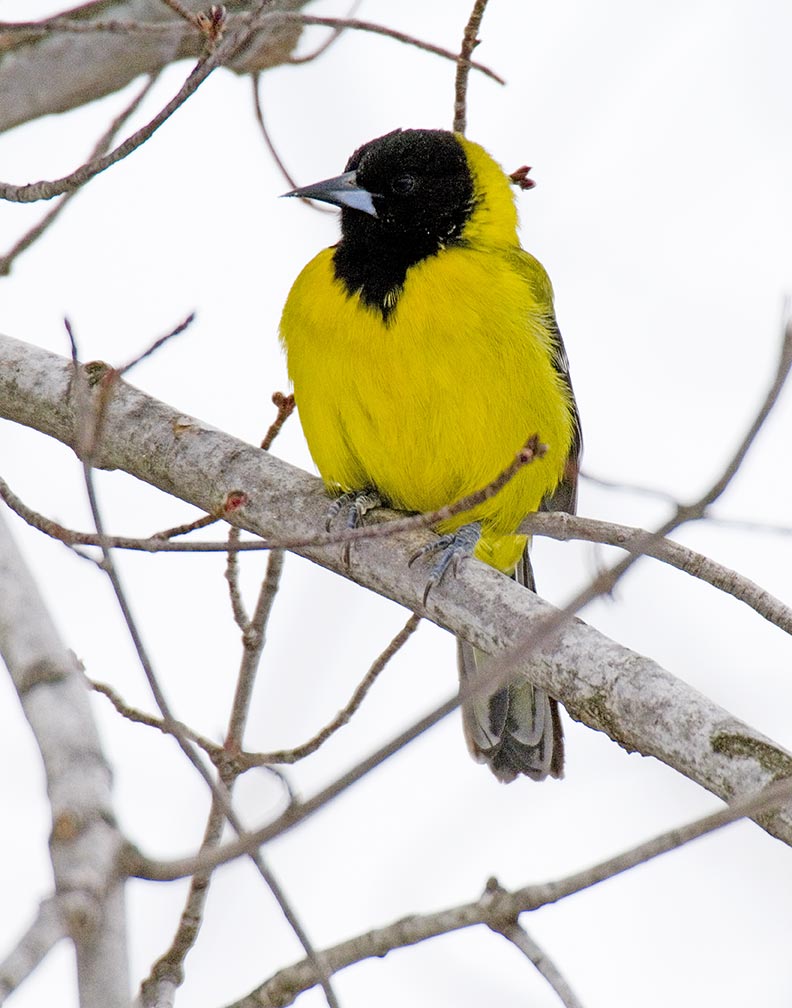Audubon's Oriole (Icterus graduacauda) - Wiki Audubon's Oriole
From Wikipedia, the free encyclopedia
Order: Passeriformes
Family: Icteridae
[Photo] Audubon's Oriole, Icterus graduacauda. Jefferson County, Indiana, February 11, 2007. An extremely rare visitor for Indiana. This is the first bird of this species seen in the United States away from Texas. Photograph by wildlife photographer Ron Austing (http://www.flickr.com/photos/45614523@N00/). Source: Flickr (http://www.flickr.com/photos/45614523@N00/388586246/).
Audubon’s Oriole (fmr. Black-Headed Oriole), is a New World passerine inhabiting the forests and thickets of southeastern Texas and the Mexican coast. It is the only species to have a black hood and yellow body. It is divided into four subspecies and two allopatric breeding ranges. The westernmost range extends from Nayarit south to southern Oaxaca, whereas the eastern range stretches from the lower Rio Grande valley to northern Quer??tano. Most common in the western range are the subspecies Icterus graduacauda dickeyae and Icterus graduacauda nayaritensis; Icterus graduacauda graduacauda and Icterus graduacauda audubonii can be found in the eastern range. Like most Central American birds, it is not a migratory species and does not display significant sexual dimorphism. DNA analysis of the ND2 and cyt-b genes strongly suggests that Icterus graduacauda is most closely related to Icterus chrysater, the Yellow-Backed Oriole (Omland, 1999). It is a member of the genus Icterus and therefore should not be confused with the Old World orioles.
Appearance
The male of the species has a black hood, mandible, and throat, as well as a black tail. Wings are black, but remiges are fringed with white and epaulets are yellow. The back and vent are yellow washed with olive, and the underside is almost uniformly yellow. Females of this species tend to have a slightly more olive nape and back than the males, and in this way the adult female’s (first-definitive) plumage is similar to the juvenal coloration; however, unlike adults, juveniles have dark brown/ olive, rather than black, coverts and primaries. In general, immature specimens have the hood; wingbars; remiges; and epaulets of adult specimens. The first-basic plumage retains the darker, greener coloration of the juvenal plumage, however. Molting generally occurs in early autumn, though some specimens have been noted to molt as early as June.
Behavior and nesting
Audubon’s Oriole inhabits dense evergreen forests and thickets, preferring riparian (riverside) areas. Though it prefers the shade, mating pairs may occasionally spotted foraging in clearings. In flight, it joins mixed-species flocks that include orioles, jays, tanagers, and other birds of similar size. The nest of the Audubon’s Oriole is similar in size and construction to those of the Hooded and Orchard Orioles, being approximately three inches in diameter with a similar depth. The nests are bag-shaped and semi-pensile; that is, they are usually found on the outer twigs of trees, rather than against the trunk. A mating pair of orioles usually incubates two broods per year, each consisting of between three to five eggs per brood; however, chicks hatched from the later brood are usually unable to survive the winter. This species’ nests are often parasitized by the Red-Eyed Cowbird.
Subspecies dickeyae
The subspecies Icterus graduacauda dickeyae is of note because of the differences in appearance, behavior, and phylogeny between it and the other subspecies of Icterus graduacauda. The olive wash is weaker, making the bird more proportionally yellow than others of its species. In addition, the yellow epaulets are diminished in dickeyae, being confined to the lesser coverts.
http://en.wikipedia.org/wiki/Audubon's_Oriole
| The text in this page is based on the copyrighted Wikipedia article shown in above URL. It is used under the GNU Free Documentation License. You may redistribute it, verbatim or modified, providing that you comply with the terms of the GFDL. |
